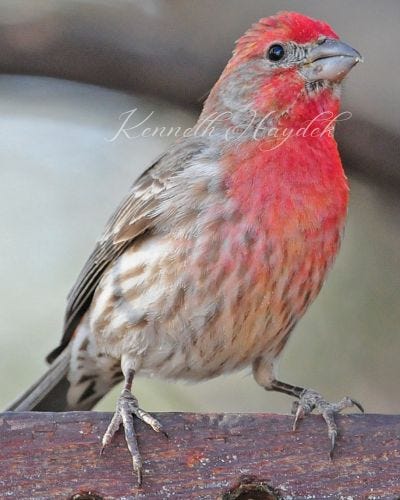February: The House Finch
You may see them regularly at your feeder or splashing around your bird bath. Although they may be a common sight, house finches have quite an uncommon history.
Their scientific name—haemorhous mexicanus—may give a clue as to the bird’s origins. Native to southwestern North America, at one time, house finches flew among desert cacti and succulents, eating their fruits and flowers, and on particularly hot days, consuming more than their own bodyweight in water.
Sometime before 1870, the house finch was introduced on the Hawaiian island of Oahu, and by 1901, the house finch was found on all the major Hawaiian Islands.
In 1940, the life history of the house finch changed even more dramatically. New York pet shop owners had tried to sell house finches as domestic caged “Hollywood finches.” To avoid prosecution from their scheme, they released the house finches on Long Island. Within 50 years, house finches had proliferated up and down the eastern coast, even into southern Canada, and moved west across the United States, virtually meeting up with their native western relatives.
House finches are small birds, not much more than five inches, with short wings, thinly notched tail, and thick conical bill that is great for busting open seed pods. The coloring of house finches is a bit tricky. As with so many species, females lack the bright coloring of males. They are plain-faced with streaky grayish brown bodies and “blurry” bars on the wings.
Male house finches have the same grayish brown on their cap, back, wings, belly, and tail. Their bright color is apparent in their eyebrows, forehead, throat, upper chest, and—when in flight—on their rump. The specific hue that a bird takes on depends entirely on what it eats. Birds absorb food pigments called carotenoids, which are found in fruits and berries that they frequently eat. The amount of carotenoids they consume will determine whether they appear bright yellow, orange, or red. In Hawaii, house finches are known as the “papaya bird,” because of their favorite local fruit, but since papayas lack carotenoids, so too do Hawaiian house finches lack the stunning bright color of their continental relatives.
Females seem to prefer to mate with the reddest male they can find. To them, the red may be an indication of a male’s capacity to find food, a characteristic that is particularly important because males as well as females feed their young; males also feed females as part of their courtship display and during incubation, which is solely done by the female.
What do house finches eat? They are nearly vegetarians with 97% of their diet coming from plant matter all year long. House finches eat fruits and berries of all kinds, cactus, thistles, millet, and seeds (including black oil sunflower seeds, if you are wondering about attracting them to your feeder). Once attracted to a particular feeding location, they may draw small flocks of 50 birds to join them. House finches will also eat tiny insects like aphids and will feed fly larvae to nestlings.
House finches form pairs in winter flocks. Females do the bulk of the work in building nests of grasses, twigs, and roots in such varied locations as palm trees, cactus, conifers, and various manmade structures. They may have 2 – 6 eggs in a clutch, with as many as six broods in a year. Females may start laying eggs while the males continue to care for a previous brood.
Regional differences among house finches are noteworthy. There are 11 subspecies of house finch, with variations in bill size, body shape, wing length, and of course, color, in different geographies. And they sound different in different places, too. House finches are known to have local accents with songs lasting longer or shorter with fewer or more syllables. Listen here to compare the songs of Californian house finches with that of New Yorkers.
One other important regional difference among house finches is health. Due to inbreeding and a smaller genetic pool, house finches in the east seem to be more susceptible to avian conjunctivitis, a bacteria that causes eye infections in the birds. Symptoms include red, swollen, and crusty eyes that leave the birds mostly blind and helpless. When avian conjunctivitis affects a bird population, many birds die, and it can take three years for a bird population to recover their former numbers. And while this eye disease began in the east, it has spread and is now affecting house finches out west, too.
If you observe birds with these symptoms at your feeder, you can report it through Project FeederWatch and follow their tips to clean your feeder. House finches are social birds, and close interaction among them spreads the bacteria. (As a general rule, even if you don’t see birds with avian conjunctivitis at your feeder, it is still a good idea to regularly clean your feeders and bird baths.)
House finches are known to be social and gregarious. If you see one, there are likely more (sometimes many more) in the area. So, keep your feeder clean and your eyes open for these bright and friendly birds!
Sources:
https://www.allaboutbirds.org/guide/House_Finch/
https://www.audubon.org/field-guide/bird/house-finch
https://ebird.org/species/houfin
https://www.audubon.org/news/10-fun-facts-about-house-finch
https://riverside.wbu.com/house-finches-fun-facts



